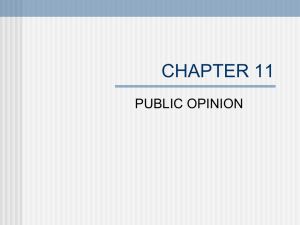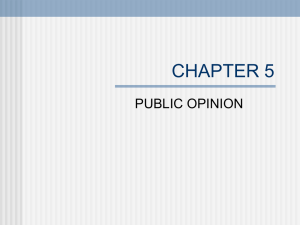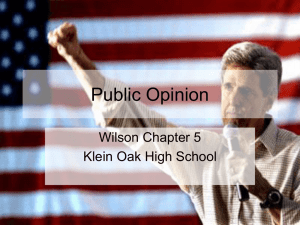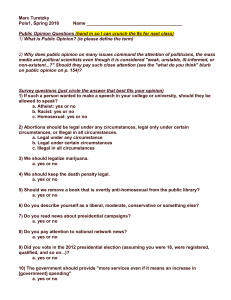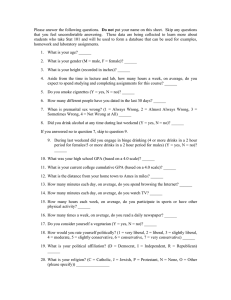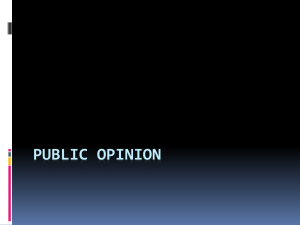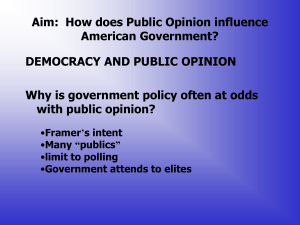Public Opinion Wilson Chapter 5
advertisement
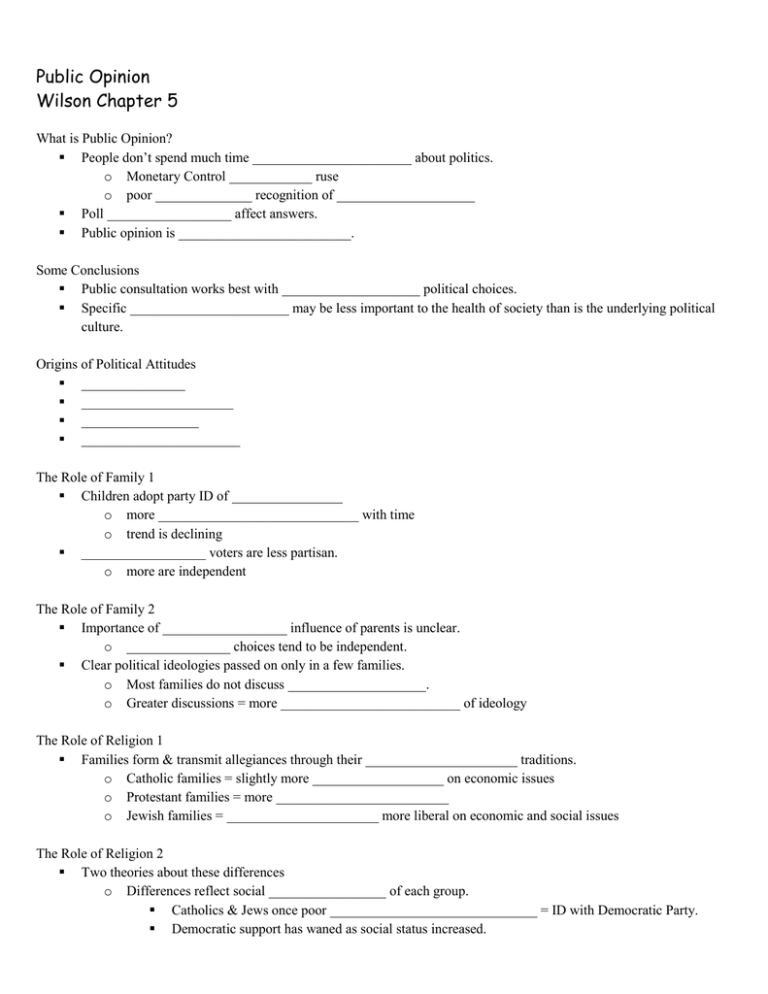
Public Opinion Wilson Chapter 5 What is Public Opinion? People don’t spend much time _______________________ about politics. o Monetary Control ____________ ruse o poor ______________ recognition of ____________________ Poll __________________ affect answers. Public opinion is _________________________. Some Conclusions Public consultation works best with ____________________ political choices. Specific _______________________ may be less important to the health of society than is the underlying political culture. Origins of Political Attitudes _______________ ______________________ _________________ _______________________ The Role of Family 1 Children adopt party ID of ________________ o more _____________________________ with time o trend is declining __________________ voters are less partisan. o more are independent The Role of Family 2 Importance of __________________ influence of parents is unclear. o _______________ choices tend to be independent. Clear political ideologies passed on only in a few families. o Most families do not discuss ____________________. o Greater discussions = more __________________________ of ideology The Role of Religion 1 Families form & transmit allegiances through their ______________________ traditions. o Catholic families = slightly more ___________________ on economic issues o Protestant families = more _________________________ o Jewish families = ______________________ more liberal on economic and social issues The Role of Religion 2 Two theories about these differences o Differences reflect social _________________ of each group. Catholics & Jews once poor ______________________________ = ID with Democratic Party. Democratic support has waned as social status increased. o Differences reflect content of religion. Jews emphasize social ________________________. __________________________ Protestants emphasize personal rectitude. The Role of Religion 3 Christian ______________________ o grass roots ______________________________ o _________________________________ affiliation The Role of Gender 1 __________________________ party affiliations of men and women o men increasingly ______________________________ since mid-60s o _________________ have identified with Democrats at about the same rate The Role of Gender 2 reflects _________________________ differences about o ___________ of government o gun ______________________ o social programs o _________ rights gender gap not unique to _______ The Role of Schooling 1 College education has ________________________________ effect o possibly due to exposure to liberalizing ideas Effect extends long after _____________________ Effect is ______________________ as more people go to college The Role of Schooling 2 Cause of this liberalizing? o personal ____________ ______________________, family, _____________________ o exposure to ______________________________ about politics o _____________________ professors The Role of Schooling 3 Increasing ______________________________ Since 1960s? o _______ – opposing legalization of marijuana and abortion o _____ – support school busing Cleavages and Public Opinion social class race and ethnicity region Social Class less important in U.S. than Europe Class voting o ______________________ sharply since 1940s Why the change? o greater exposure to liberalizing effects of higher education o ________________________________ issues now define liberal and conservative o moral, symbolic, & _____________________ policy issues do not divide rich and poor in same way Race and Ethnicity Similarities and differences between blacks and whites are ___________________ ____________________________ differences also surface among African Americans Difference between __________________ and citizens o in black community o in white community No _____________________ voters have become predictably partisan in their voting Region 1 White southerners once more conservative than other regions regarding o _________ to minorities, o legalizing marijuana, o school ___________________, and o rights of the ___________________ White southerners about the same as other regions on economic issues Region 2 Traditionally, white southerners were solidly __________________________ o the “solid south” – for Democrats Political views today are __________ regionally distinct Today, white Southerners are less ____________________ to the Democratic Party than in the past. Political Ideology 1 _________________________ and ___________________ set of political beliefs about who ought to rule, the principles rulers ought to obey, and what _____________________ rulers ought to pursue measured in terms of o How frequently they self-________________ or describe their choices as liberal, conservative, etc. o Whether their ______________ preferences are consistent over time, or are based on consistent principles Political Ideology 2 Yet people may have strong _____________________________ even if they do not satisfy these conditions Other people may cross the _________________ of traditional liberalism or conservativism in their issue affiliations Liberalism and Conservativism? 1 Labels have a complex history Early 1800s o ____________________ supported personal _________________ o _______________________ liberty conservatives supported restoring the authority of state __________________ aristocracy Liberalism and Conservativism? 2 ________________________ & New Deal changes things o liberals support _________________________ government o conservatives reaction to activism (___________________________) ____________ markets _______________ rights individual ______________ in economics Today labels are imprecise and changing Categories of Public Opinion 1 Economic policy: ___________________ favor o ________ for all, o _____________________ medical care and education, o increased taxation of the ___________ Civil rights: liberals favor o strong __________________ action to desegregate schools, o create _____________________ opportunities for minorities, and o strict enforcement of _______________ rights law Categories of Public Opinion 2 Public and political conduct: _________________ are o __________________ of protest demonstrations, o favor _________________________ of marijuana, o emphasize protecting the rights of the accused, and o respond to crime by seeking to eliminate its ___________________ Analyzing Consistency People _________ liberal and conservative positions on these categories See following slides! Pure ____________________ liberal on both economic and personal conduct issues 1994, ______ percent of the population Pure ____________________________ conservative on both economic and personal conduct issues 1994, _______ percent of the population ______________________ conservative on ______________________ issues, liberal on personal conduct issues 1994, about ______ percent of the population _______________________ liberal on _________________________ issues, conservative on personal conduct issues 1994, about ______ percent of the population Political Elites those who have a disproportionate amount of some valued __________________ Elites, or _________________________, display greater ideological consistency o more information and more ___________________ in politics than most people, so they may see more relationships among the issues o Their peers reinforce this consistency. Is there a “new class”? those who are __________________________ by the power, resources, and growth of government (not by business, as elites previously were) Two explanations of __________________ individuals who are liberals o Directly benefit from _____________________________ o Liberal ideology is now ________________________ postgraduate education Middle Class Split? 1 Traditional middle class: o __________ years of college, o suburban, o ______________ affiliated, o pro business, o conservative on social issues, o ________________________ Middle Class Split? 2 Liberal middle class (or new class): o ________________________ education, o urban, o critical of ___________________________, o liberal on social issues, o ______________________ Emergence of new class creates a greater strain in Democratic party Political elites, public opinion, and public policy Elites influence public opinion in two ways o Raise and _____________ political issues o State _____________ by which to settle issues and define policy options Limits to elite influence on the public Elites do not define economic, crime, and other problems that are rooted in personal _____________________ Elites contradict and ___________________ with one another, limiting their influence
